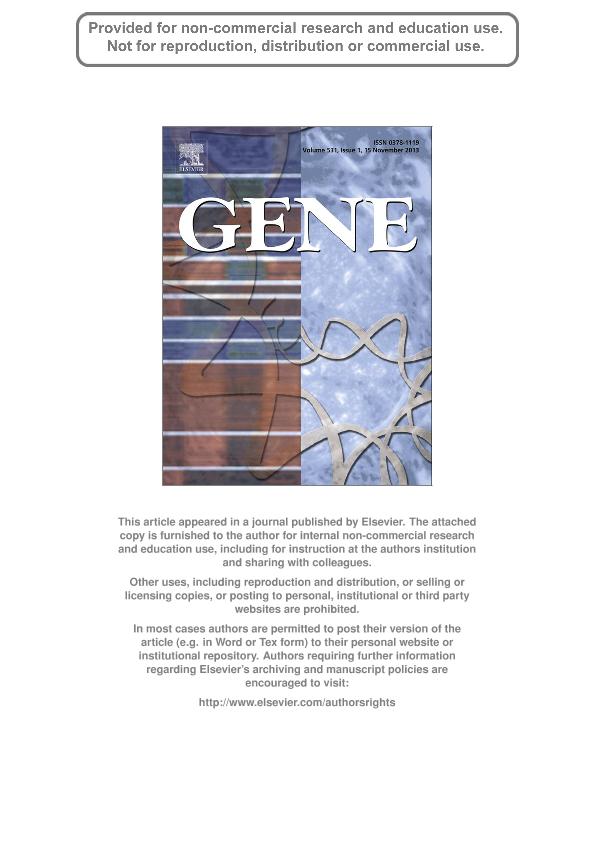Mostrar el registro sencillo del ítem
dc.contributor.author
Botto, Javier Francisco

dc.contributor.author
Crocco, Carlos Daniel

dc.date.available
2016-02-05T19:47:50Z
dc.date.issued
2013-08-27
dc.identifier.citation
Botto, Javier Francisco; Crocco, Carlos Daniel; BBX proteins in green plants: Insights into their evolution, structure, feature and functional diversification; Elsevier; Gene; 535; 1; 27-8-2013; 44-52
dc.identifier.issn
0378-1119
dc.identifier.uri
http://hdl.handle.net/11336/4085
dc.description.abstract
The B-box domain is conserved in a large number of proteins involved in cell growth control, differentiation and transcriptional regulation among animal and plant species. In Arabidopsis thaliana, some works have found that B-box proteins (BBX) play central developmental functions in flowering, light and abiotic stress signaling. Despite the functional importance of this protein family, evolutionary and structural relationships of BBX proteins have not been extensively investigated in the plant kingdom. Using a phylogenetic approach, we conducted a comprehensive evolutionary analysis of the BBX protein family in twelve plant species (four green algae, one moss, one lycophyte, three monocots and three dicots). The analysis classified 214 BBX proteins into five structure groups, which evolved independently at early stages of green plant evolution. We showed that the B-box consensus sequences of each structure groups retained a common and conserved domain topology. Furthermore, we identified seven novel motifs specific to each structure group and a valine–proline (VP) pair conserved at the C-terminus domain in some BBX proteins suggesting that they are required for protein–protein interactions. As it has been documented in mammalian systems, we also found monopartite and bipartite amino acid sequences at the C-terminus domain that could function as nuclear localization signals (NLSs). The five BBX structure groups evolved constrained by the conservation of amino acid sequences in the two B-boxes, but radiating variation into NLSs and novel motifs of each structural group. We suggest that these features are the functional basis for the BBX protein diversity in green plants.
dc.format
application/pdf
dc.language.iso
eng
dc.publisher
Elsevier

dc.rights
info:eu-repo/semantics/openAccess
dc.rights.uri
https://creativecommons.org/licenses/by-nc-nd/2.5/ar/
dc.subject
B-Box Proteins
dc.subject
Cct Domain
dc.subject
Nuclear Localization Signals (Nls)
dc.subject
Plant Evolution
dc.subject.classification
Biología del Desarrollo

dc.subject.classification
Ciencias Biológicas

dc.subject.classification
CIENCIAS NATURALES Y EXACTAS

dc.subject.classification
Ciencias de las Plantas, Botánica

dc.subject.classification
Ciencias Biológicas

dc.subject.classification
CIENCIAS NATURALES Y EXACTAS

dc.title
BBX proteins in green plants: Insights into their evolution, structure, feature and functional diversification
dc.type
info:eu-repo/semantics/article
dc.type
info:ar-repo/semantics/artículo
dc.type
info:eu-repo/semantics/publishedVersion
dc.date.updated
2016-03-30 10:35:44.97925-03
dc.journal.volume
535
dc.journal.number
1
dc.journal.pagination
44-52
dc.journal.pais
Países Bajos

dc.journal.ciudad
Amsterdam
dc.description.fil
Fil: Botto, Javier Francisco. Consejo Nacional de Investigaciones Científicas y Técnicas. Oficina de Coordinación Administrativa Parque Centenario. Instituto de Investigaciones Fisiológicas y Ecológicas Vinculadas a la Agricultura; Argentina
dc.description.fil
Fil: Crocco, Carlos Daniel. Consejo Nacional de Investigaciones Científicas y Técnicas. Oficina de Coordinación Administrativa Parque Centenario. Instituto de Investigaciones Fisiológicas y Ecológicas Vinculadas a la Agricultura; Argentina
dc.journal.title
Gene

dc.relation.alternativeid
info:eu-repo/semantics/altIdentifier/url/http://www.sciencedirect.com/science/article/pii/S0378111913010676
dc.relation.alternativeid
info:eu-repo/semantics/altIdentifier/issn/0378-1119
dc.relation.alternativeid
info:eu-repo/semantics/altIdentifier/doi/http://dx.doi.org/10.1016/j.gene.2013.08.037
Archivos asociados
